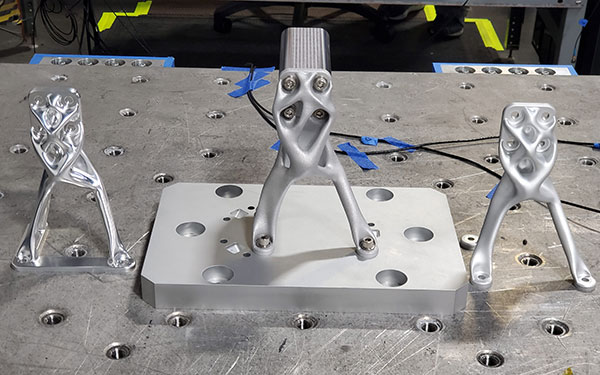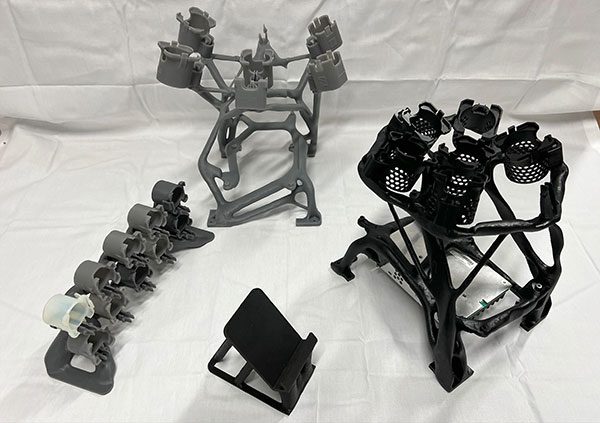
A part for the NASA EXCITE project designed using Autodesk Fusion 360’s generative design tools, CNC machined by Protolabs. Image courtesy of Ryan McClelland, NASA.
Latest News
April 5, 2022
Carl Sagan once said, “All civilizations become either spacefaring or extinct.” In that sense, Ryan McClelland, research engineer for NASA’s Goddard Space Flight Center, is doing his part to prevent the extinction of humans.
A mechanical engineer by training, he described himself as “stronger in design than in analysis.”
The Instrument Systems Division where he works, he explains, is not like a typical car company. “We’re not making the same part over and over. We’re driven by nonrecurring engineering. With every mission, we’re making something new, whether it’s to measure something in the ocean or on the moon,” he says.
McClelland discovered generative design during the pandemic. With the free time he had during the shutdown, he was watching YouTube clips, exploring various software packages and delving deeper into additive manufacturing (AM). The role of AI in generative design and the unorthodox shapes produced by the method intrigued him.
“To me, those organic shapes are how things are supposed to look. Not the typical square objects with rounded corners,” he says. He currently uses Autodesk Fusion 360, an integrated design suite with cloud features and generative design tools.
How to Speak to Generative Design Algorithms
McClelland quips that his early trials of generative design “was like collaborating with a talented sculptor. He comes up with a beautiful shape but also blocks all your bolt holes.” But over time, he learned to encode standard NASA requirements, such as the required distance between bolt edges, and figured out ways to place obstacles in the right places to direct the outcome of the auto-generated shapes.
McClelland observes:
“As human engineers, we know these rules in our minds, but to find ways to make them explicit to the computer was sometimes a stumbling block.”
The general strategy used by generative design software to shape optimal topology is founded in established finite element analysis (FEA) principles. The setup for a generative design study usually involves defining loads and boundary conditions on a rough piece of geometry.
McClelland continues:
“You don’t need to be an FEA expert to run generative design software. Besides, if you’re a mechanical engineering student, you should understand basic loads and constraints.”
FEA Expertise Not Required
“Most major engineering simulation software vendors are actively pursuing some form of generative design strategy with the scope to broaden supported scenarios and make the process understandable to non-analysts,” says Joe Walsh, CEO and founder of IntrinSIM, also CEO and co-founder of the Analysis, Simulation & Systems Engineering Software Strategies (ASSESS) Initiative.
Ben Servey, a mechanical engineering student from Pennsylvania State University, worked alongside McClelland on a senior capstone project to design and prototype a part for the Off-Plane Grating Rocket Experiment mission.
“Experience with FEA helps, but is by no means necessary,” Servey says. “The biggest similarities between FEA and generative design is that you have to apply the forces and constraints, as well as general simulation setup, such as mesh size.”
Servey found the sequential setup of Autodesk Fusion 360’s generative design tools helpful. “This made it easy to know what the next step in setting up the simulation was,” he says.
Over time, Servey also learned certain correlations between the input and the outcome. For example, denser meshes tend to produce higher factor-of-safety values in his experiments. It would make generative design software much easier to master if the user interface includes popup tips and explanations “to explain how each of the different simulation settings might affect the results,” he says.
Many users have noted that generative design tends to propose solutions that human engineers might not have considered on their own. Some go so far as to describe the asymmetrical structures and membrane-like trusses seen in generative design studies as “alien geometry.”
“What’s fascinating is that when you get the right answer, it looks right. When you get the wrong answer, it looks wrong,” McClelland says. “As humans, when we see trees, animals and bones, we just know why they’re that way.”
Unforeseen Design
McClelland put generative design to use to design a part for the NASA Exoplanet Climate Infrared Telescope (EXCITE) project, which aims to take spectrographic measurements of planets.
“A human designer came up with a bracket as the way to deal with it,” McClelland says. “But generative design used a criss-crossing pattern, which resulted in a much stiffer part. And those criss-crossing bands prevent the bracket from twisting. A human designer would not have thought of that.”
The prototype designs were produced in computer-numerically controlled (CNC) machines by Protolabs (three-axis) and Zero Hour (five-axis) and 3D printed by 3D Systems in Al10SiMg and A6061-RAM2 aluminum alloy.

Three variations of a part for the NASA EXCITE project, produced by a five-axis CNC machine from Zero Hour (left), a printer from 3D Systems (center) and Protolabs (right). Image courtesy of Ryan McClelland, NASA.
Even failed generative design experiments gave McClelland valuable insights about the design. Sometimes the odd results forced him to reexamine whether the stress concentrations influencing the geometry were valid or artificial, whether they were the result of incorrect loading or unreasonable obstacles.
“My strategy is to first let the software run with all the freedom. If I don’t know where to put bolts, I first run it without specifying them. Then based on where the geometry touches, I’d say, maybe that’s where I’ll put my bolts,” he says.
Based on how he discovered generative design and learned at his own pace, McClelland urged software developers to enable easy access to training materials.
“I got 90% of the way just through YouTube videos. It’s important to make it easy to find the answer so users can, for example, search in Google and find out how to apply loads and constraints,” McClelland says.
See If You Can Figure It Out
Last year, Jeff Olsen, president of Hiller Measurements, was shopping for a stereolithography printer for prototyping. He flew out to Chicago to attend the Rapid + TCT Conference—one of the few in-person events that took place in the narrow window between the delta COVID variant’s decline and the omicron variant’s rise.
“When I got to the show, everyone was talking about generative design,” Olsen recalls. “I went to a few demos. Everyone seemed to be looking at it as a weight-saving method. But when I saw it, I thought of it as a way to collapse the workflow, to enable my design staff to complete in minutes what usually took weeks.”
Olsen’s software choice was PTC’s Generative Design Extension for PTC Creo software users. The technology came from PTC’s 2018 acquisition of the generative design startup Frustum. Olsen installed it on a laptop, then asked a staff member to figure it out. The chosen employee didn’t have much experience in analysis.
“After learning the software from YouTube videos, he came to me the next day and said, ‘I think I know how to run these generative design studies.’ Then he showed me a cellphone clip he designed with it, and I knew we could make this work,” recalls Olsen.
Generative Design Plus AM
In Olsen’s view, generative design and AM is an ideal combination that enables Hiller Measurements to vertically integrate formerly outsourced processes involving on-demand 3D printing bureaus. This also allows design iteration through trial and error—or, as Olsen puts it, “the print-and-break approach.”
Hiller’s staff put generative design to the test by designing a structurally complex radiofrequency (RF) relay-switch holder, used in wireless telecom operations. The ideal design must accommodate multiple relay switches with the shortest possible cable connections among them. Components should be positioned in the best orientation with greater freedom, rather than orthogonally laid out on aluminum trays as was done formerly.

Hiller Measurements’ RF clip system shown here is designed in PTC Creo’s Generative Design tools. The single 3D-printed piece replaces what used to require 10 panels, reducing design complexity and the production cycle. Image courtesy of Jeff Olsen, Hiller Measurements.
With the move to generative design plus additive manufacturing, Hiller Measurements has improved RF performance, reduced parts quantity by 90% and collapsed the design-to-finished-part times by a factor of 10. A single 3D-print design replaced over 10 aluminum panels and mounting mechanisms for power supplies, printed circuit boards and other components, Olsen points out.
Olsen confessed he would not have conceived the same design using his own knowledge and know-how, but in physical testing, the generative design solution performed well. Learning the software was less of a struggle; rather, giving up the traditional approach was the bigger struggle, Olsen explains.
“Making the potential paradigm shift enabled by generative design a reality will require both organizational/cultural changes and a broadening of available software capabilities to cover a broader range of design scenarios with generative design,” Walsh notes.
With generative design, “It’s not your job to design the product anymore. Your job is to design the constraints and allow software to design. Quite frankly, even though you may or may not like the generative design aesthetics, from a business perspective and engineer perspective, it makes more sense,” Olsen says.
The porous organic structure also vastly improved airflow in Hiller’s chassis designs—an unforeseen advantage. To Olsen personally, the frame is also aesthetically captivating. At the moment, Hiller Measurements is 3D printing them, but the company is also exploring injection molding of higher volume parts.
To help potential users determine if generative design is suitable for their projects, ASSESS published a checklist of key capabilities.
The organization points out that the generative design algorithms should consider “factors from multiple areas including operational performance, weight/mass, manufacturing, assembly or construction, usability, aesthetics, ergonomics and cost.”
More 3D Systems Coverage
More ASSESS Initiative Coverage
Subscribe to our FREE magazine, FREE email newsletters or both!
Latest News
About the Author
Kenneth Wong is Digital Engineering’s resident blogger and senior editor. Email him at kennethwong@digitaleng.news or share your thoughts on this article at digitaleng.news/facebook.
Follow DE





